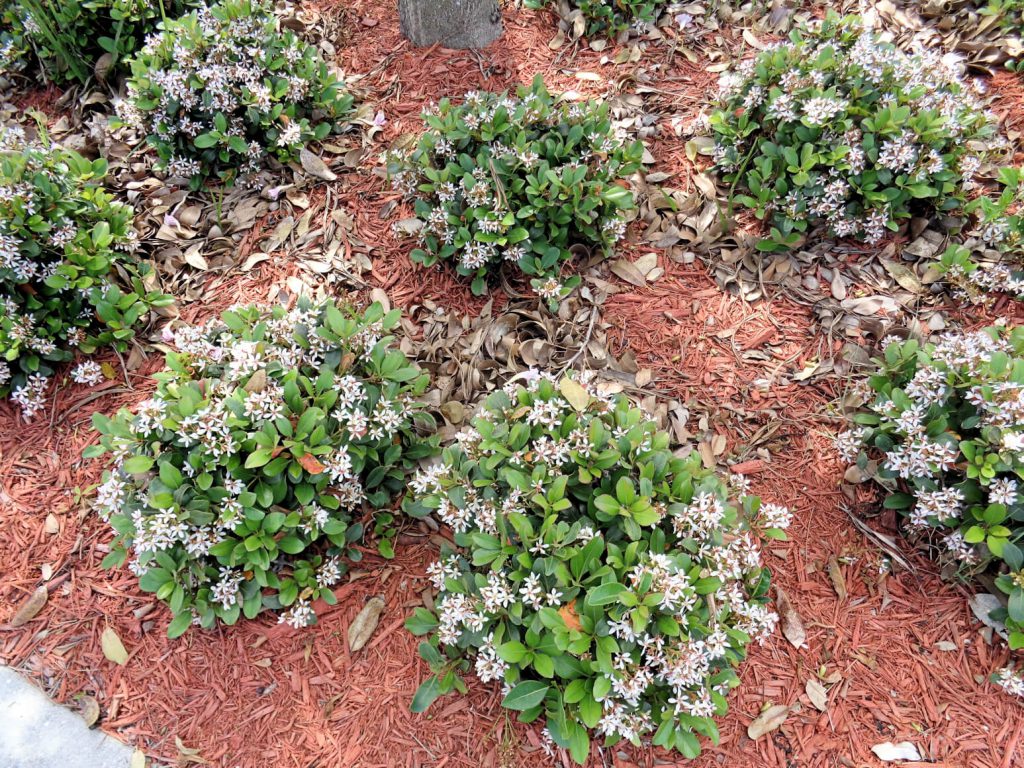By Ralph E. Mitchell

Do you have a Raphiolepis indica or two in your landscape? If you don’t have the Indian Hawthorn in your landscape, you will probably see them included in many landscapes as well as in and around commercial or institutional settings. The Indian Hawthorn evergreen shrubs are naturally spreading and relatively short in size. While they grow slow, they can reach a height of up to seven feet tall, and to ten feet wide. I’ve never seen them this large, so take heart that the growth is slow and manageable – a mere three feet tall and wide in our parts. If you do not already have these “short spreaders” of the landscape world, they can make an attractive impact in your yard.
Medium in texture, Indian Hawthorn have two to four inch, rich grey-green leaves that are highlighted in the spring by pink, fragrant flowers – now in bloom. Although Indian Hawthorn will grow in a range of light conditions from part shade to full sun, they do best in full sun. In fact, Indian Hawthorn can lose foliage to a leaf spot disease in part shade situations. Plant density, flower and fruit production will also be reduced in less than six hours of sun. Additionally, to avoid providing the environment for foliar disease such as leaf spot, plan on no overhead irrigation if possible. The Indian Hawthorn is drought tolerant, and once established, these shrubs can survive with low water needs. In partnership with this good characteristic is their salt tolerance. This is a great seaside plant subject.
Set your Indian Hawthorns out in the landscape on four-foot centers to accommodate future spread considering that they will grow wider over time. If any minor pruning is needed, make sure to always leave the bottom of the plant wider than the top. This will ensure that sun will get to all parts of the shrub and, accordingly, the foliage will be full.
The Indian Hawthorn family has a variety of cultivars available with different sizes, leaf color and flowering features that are worth trying. ‘Ballerina’ is a one to two-foot dwarf variety with dark pink flowers. ‘Enchantress’ is another dwarf that blooms from late winter to early spring. ‘Fascination’ features a very compact plant with star-shaped rose-colored flowers with white centers. ‘Hines Darkleaf’ is a patented cultivar that has green or maroon new foliage color and dark purple fall color. ‘Snow White’ features dwarf spreading growth with white flowers. If you can find them, there are certainly lots of cultivars for the Indian Hawthorn connoisseur! Check local family-run garden centers or on-line for cultivars available from specialty nurseries.
Let the Indian Hawthorn be part of your landscape if you require short and spreading shrubs to add texture to your yard. This small shrub is also a Florida-Friendly Landscaping™ approved plant! For more information on all types of great shrubs for Southwest Florida, or to ask a question, please visit https://www.facebook.com/CharlotteMGLifeline/. Ralph E. Mitchell is the Director/Horticulture Agent for the UF/IFAS Charlotte County Extension Service. He can be reached at 941-764-4344 or ralph.mitchell@charlottecountyfl.gov.
Resources:
Gilman, E. F. (1999) Raphiolepis indica, The University of Florida Extension Service, IFAS.
Bolles, B. (2015) Plan Carefully with Indian Hawthorn. The University of Florida Extension Service, IFAS – Escambia County.
Stevenson, C. (2019) Keep an Eye on your Indian Hawthorn. The University of Florida Extension Service, IFAS – Escambia County.
Landre, C. (2011) Raphiolepis indica – Indian Hawthorn. South Florida Plant Guide.
The Florida-Friendly Landscaping™ Guide to Plant Selection & Landscape Design (2010) The University of Florida Extension Services, IFAS.
 0
0
